Allogeneic stem cell transplantation (SCT) provides a curative option for many patients with relapsed hematologic malignancies and for others with high risk of recurrence after initial therapy. Traditionally HLA-matched sibling donors were preferred as the source of stem cells, but the availability of such a donor in only about one-third of patients has led to the use of matched unrelated donors. This French multicenter study assessed the outcomes for patients with standard-risk hematologic malignancies undergoing allogeneic SCT from related versus unrelated donors, utilizing a uniform pre-transplant conditioning regimen of total body irradiation plus high-dose cyclophosphamide and uniform graft-versus-host disease (GVHD) prophylaxis with cyclosporin-A and short-course methotrexate for all patients. The study population included patients with acute leukemia in first or second complete remission, CML, and myelodysplastic syndrome. Bone marrow rather than peripheral blood was used as the source of stem cells for all patients. One hundred and eighty-one patients had an HLA-matched sibling donor, while 55 had an HLA-matched unrelated donor identical at 10/10 allelic loci. Patient characteristics in the two groups were largely comparable, and all but seven patients engrafted. With a median post-transplantation follow-up of 34.6 months, there was no significant difference in time to engraftment, acute GVHD, event-free survival, or overall survival (Figure). A retrospective review of patients in this trial showed increased occurrence of chronic GVHD in unrelated versus sibling transplants. Mortality was increased in CMV seropositive recipients, in those who developed >/= grade II acute GVHD, and in those with stem cell donors > 37 years of age.
With a Median Post-Transplantation Follow-Up of 34.6 Months, There was No Significant Difference in Time to Engraftment, Acute GVHD, Event-Free Survival, or Overall Survival. Yakoub-Agha I, Mesnil F, Kuentz M, et al; French Society of Bone Marrow Transplantation and Cell Therapy. Allogeeic marrow stem-ce transplantation from human leukocyte antigen-identical siblings versus human leukocyte antigen-allelic-matched unrelated donors (10/10) in patients with standard-risk hematologic malignancy: a prospective study from the French Society of Bone Marrow Transplantation and Cell Therapy. J Clin Oncol 2006;24:5695- 02. Reprinted with permission from the American Society of Clinical Oncology.
With a Median Post-Transplantation Follow-Up of 34.6 Months, There was No Significant Difference in Time to Engraftment, Acute GVHD, Event-Free Survival, or Overall Survival. Yakoub-Agha I, Mesnil F, Kuentz M, et al; French Society of Bone Marrow Transplantation and Cell Therapy. Allogeeic marrow stem-ce transplantation from human leukocyte antigen-identical siblings versus human leukocyte antigen-allelic-matched unrelated donors (10/10) in patients with standard-risk hematologic malignancy: a prospective study from the French Society of Bone Marrow Transplantation and Cell Therapy. J Clin Oncol 2006;24:5695- 02. Reprinted with permission from the American Society of Clinical Oncology.
In Brief
This study supports the conclusion that curative outcomes for 10/10 HLA-matched unrelated donors are comparable to matched sibling donors for patients transplanted for standard-risk hematologic malignancies. Additional studies will be needed to determine the impact of alternative conditioning regimens, peripheral blood rather than marrow stem cells, related- versus unrelated-donor nonmyeloablative allogeneic SCT, alternative GVHD-preventive regimens, and the impact of these on and for higher-risk hematologic malignancies.
Competing Interests
Dr. Williams indicated no relevant conflicts of interest.

